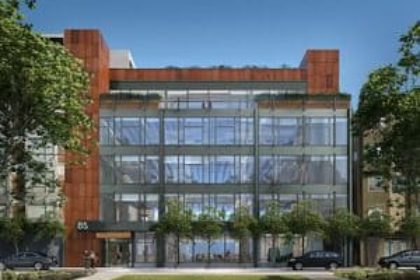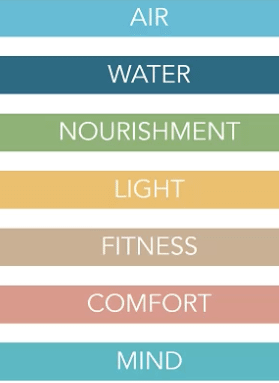Well Building Standard Certification for Occupant Health

WELL BUILDING STANDARD – How to apply it to any project
There is a new green certification in town. It is called the WELL Building Standard and it targets the ways in which buildings can enhance occupant health. Indicative of the increasing emphasis on how work areas are designed (i.e., Google, Facebook, Air Bnb, LinkedIn), the first version addresses offices for commercial and institutional settings. Offices are an interesting arena to start with, unlike residential projects, an office’s main function is to provide a space which fosters work. By creating a green certification specifically focused on employee health, WELL links good office design to a company’s prosperity. It also broadens the scope of what constitutes sustainable building design. WELL does have pilot versions out that concentrate on other building typologies such as multi residential, public assembly, health care, and educational facilities, yet for the time being, the principles of this first round can be applied to your current building project. Below is an overview of what the WELL Building Standard addresses and how to frame it to suit your particular needs.
WELL Building Standard is divided into seven “Concepts” these concepts consist of Air, Water, Nourishment, Light, Fitness, Comfort, & Mind. Within these concepts are “Features” which explain specific design strategies to employ. Similar to LEED there are features that you have to meet called “Preconditions” and features that will earn you a higher rating, called “Optimizations”. Concepts such as Air & Water deal with more obvious health areas. Some of Air’s important elements include best ventilation and filtration practices as well as material selection, and construction pollution mitigation. With home construction becoming increasingly tighter, these parameters take on greater significance. One needs to make sure that carbon dioxide levels stay in check and that buildings receive ample amounts of fresh air from the outdoors. Different filters address different pollutants. For example, carbon filters take care of VOCs (volatile organic compounds), ozone, and large particles. Media filters take on smaller particulate matter that can be inhaled deep into the lungs, and UV sanitization targets microbes, bacteria, and viruses. In a tightly sealed home, having an air filtration system serves as an ace in your back pocket. Similar to Air, Water addresses common contaminants to set parameters for and where they come from. For instance, sources of water pollution come from pesticides (atrazine, glyphosate), public additives (chlorine & chloramine as well as their byproducts: trihalomethanes and haleoacetic acid), synthetic chemicals (found in consumer goods & building materials), and inorganic compounds such as lead, mercury, & arsenic. There are different water filtration strategies used depending on what you want to target. Akin to air filtration, the Water concept recommends carbon filters, UV filters, and sediment filters (which are similar to what media filters do).
Light & Comfort are two other concepts that WELL addresses. Both concepts have technical components but they are more nuanced. These concepts ask the team to focus on a set of design strategies to make sure there is healthy light and healthy forms of comfort. Yet in order to get started you have to first know what healthy light and comfort mean.
Two of Light’s primary focal points are glare mitigation and lighting design for maximum productivity. Light addresses color temperature (how light hues relate to natural light at a given time of day), CRI (a light source’s ability to mimic the full light spectrum), lumens (brightness of the light) and lux (the amount of light in a given space). According to the WELL BUILDING STANDARD, spaces aimed at productivity should have color temperatures between 5000k & 65000K. These temperatures correspond to the light one experiences at noon. It also suggests that CRI should be at least 80 or above, fortunately LEDs are now available with CRIs of 90 & above. In addition to light sources, the Light concept addresses how surfaces play a role in shaping how light is perceived. LRVs or Light Reflectance Values measure a surface’s ability to reflect light away from themselves. Walls, ceilings and furniture are all given values intended to encourage focus and alertness. At the same time, the magnitude of this reflection is controlled by glare mitigation strategies; these are aimed at managing glare from solar and electric light sources such as windows & lamps. Considerations include window shading devices – that are automatic, self controlled, and/or part of the glass, as well as the relationship between bulb light intensity and the angle needed to diffuse it.
A large part of the Comfort section has to do with acoustics, ergonomic furniture selection, and thermal comfort. WELL’s features walk projects through important metrics to focus on such as NIC (Noise Isolation Class), NRC (Noise Reduction Coefficient), reverberation time (RT60) and NC (Noise Criteria). All have to do with making sure acoustics are not too loud, support a sense of privacy, and are diffused evenly. In addition to sound, Comfort addresses musculoskeletal health through ergonomic furniture including adjustable seats and standing desks. Thermal comfort is addressed through ASHRAE 55 building code, radiant heating, humidity, and temperature variations throughout the space.
Nourishment and Fitness – have more to do with how offices, known as sedentary places, promote movement as well as how the environment can promote proper eating. These two features do not apply as much to residential projects because occupants are feeding themselves and in charge of their own movement. Nevertheless anyone can benefit from knowing that you should have federally organic and humane certified meat and produce, multiple servings of fruits and vegetables a day, and avoid refined sugar and trans fat. What I find most interesting about the Fitness section was how Fitness can be integrated into the layout of the building, such as having stairs that are readily available and aesthetically pleasing to walk up. Landscape design is also included to encourage walking and exploration.
The last concept is the the Mind concept. The Mind concept deals with design details that some brush off as purely aesthetic but in all reality, actually makes a great impact on the desirability of a space. According to the Mind concept whether a space feels good or not has a direct correlation to one’s psychological and physical states. Two of Mind’s features are based on the imperatives of the Living Building Challenge (another green building certification) – one is named Biophilia which emphasizes the importance of being surrounded by different forms of nature such as plants, water, natural light, and stones. Sources of nature improve air quality, calm the nervous system, and make people feel a part of a greater ecosystem. The other Living Building Challenge Imperative explored is feature Beauty & Design. This addresses formal qualities that charge a space with energy or calm it down with tranquility. Art, high ceilings, placement of furniture, and color selection can all contribute to an interior environment’s ability to create a sense of well being.
The WELL Building Standard is unlike other building standards in that it asks project teams to design environments to achieve a sense of emotional well being. Our WELL AP’s work with architects, engineers, owners, & facility management teams, and are required to meet regularly to discuss the ways in which all concepts promote occupant health. Developing a comprehensive plan for this is not so clear cut, WELL provides guidelines, but it asks the teams to define its own values and find a way to achieve them. This might not be so different from what good design firms do, but by making it a certification system, WELL pushes nuanced thinking into the mainstream.




